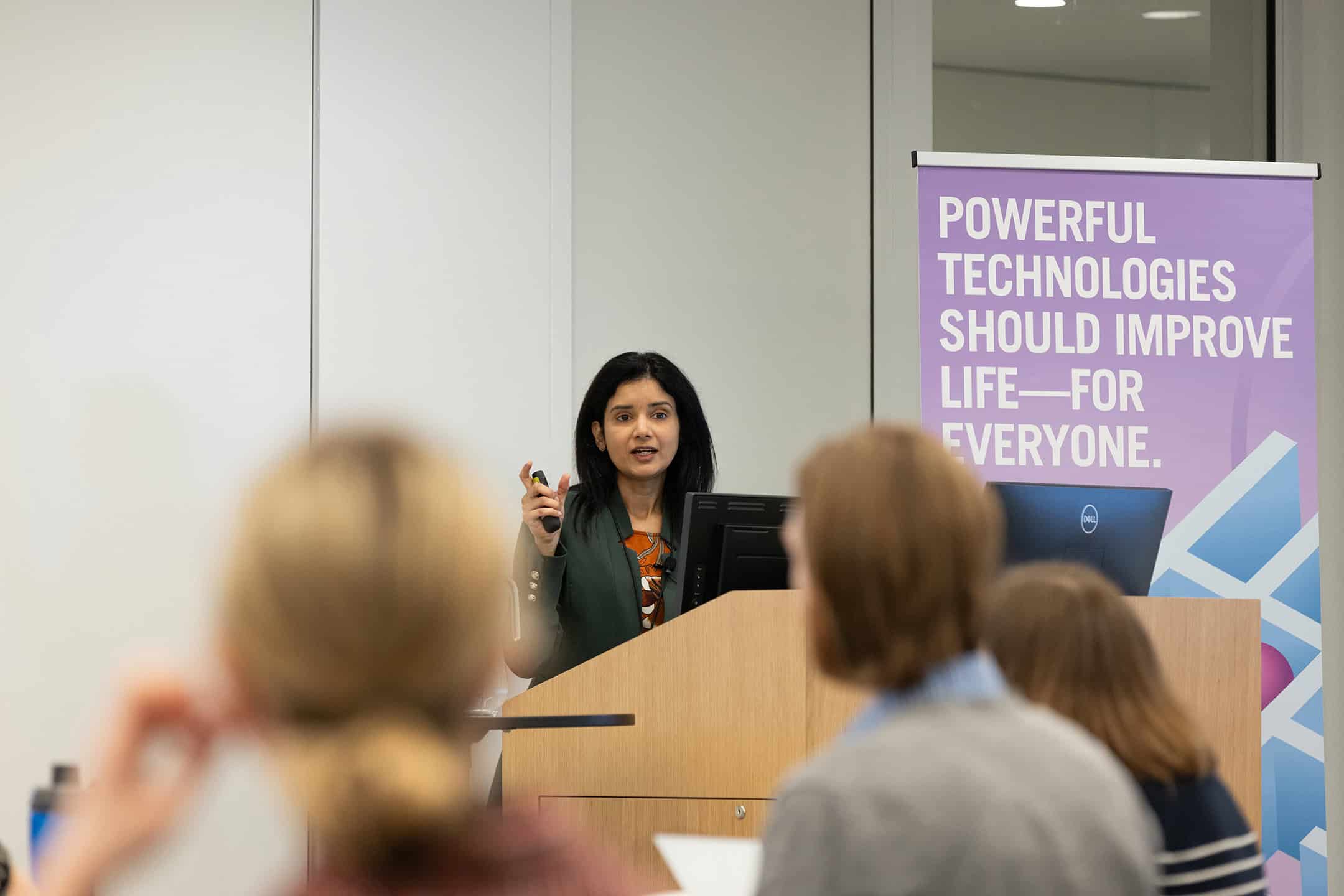On May 6, 2024, the graduate workshop of Absolutely Interdisciplinary at the Schwartz Reisman Institute for Technology and Society began with an introduction and transitioned into a discussion about artificial intelligence (AI) in healthcare. Dr. Mamatha Bhat, Daniel Buchman, and Muhammad Mamdani presented their research on AI and how it is being applied in their healthcare fields.
Computer science and equitable liver transplantation
Dr. Bhat, a hepatologist specializing in liver disease at the University Health Network, delivered a talk titled “Leveraging Interdisciplinary Approaches for Equitable Outcomes in Transplant.” During her PhD at U of T, she developed an interest in AI and recognized its potential to enhance hepatology by predicting complex, personalized liver tissue patterns. She also identified how doctors can use AI in liver transplantation.
She observed inequities in the liver transplant waitlist, noting that the prioritization system in the US disadvantages women and individuals with liver disease. Her analysis revealed a shift in the patient population since the system was first implemented: women and individuals with liver disease now represent a different percentage of the patient population, but the system still prioritizes transplants according to the old numbers. To address this, Dr. Bhat collaborated with computer scientists to better align patient data with AI models. She noted that this collaboration could result in a new tool that adjusts the prioritization system.
Dr. Bhat emphasized the tool’s potential for achieving more equitable outcomes in critical situations requiring liver transplants on an international scale. She concluded by highlighting the crucial role of effective communication between computer scientists and healthcare professionals in advancing medical practices, including transplantation.
Ethical concerns of AI in psychiatry: Can stigma be trained?
Buchman, a scientist at the Centre for Addiction and Mental Health, delivered a talk titled “Potential Unintended Ethical Consequences of AI in Psychiatry.” He explored how professionals could lead efforts to address issues of mental health stigma and low compassion for patients to improve treatment and patient care. To illustrate his points, Buchman used an example involving a patient, a machine learning (ML) — computer systems that learn from data without explicit instructions — program, and a surveillance tool for prescription information. He questioned whether professionals could guide AI development to better address inequity issues in treating patients.
Buchman highlighted that patient-centred care, which emphasizes treating each patient with dignity and respect, continues to be challenged by mental health stigmas — particularly impacting already disadvantaged populations. People facing various mental health and substance abuse issues often encounter biases, and changing societal perceptions of technology remains difficult. Individuals with mental illness frequently experience epistemic injustice, where their experiences are devalued because their knowledge is discredited based on their perceived identity.
Buchman recommended promoting epistemic humility using AI and ML in psychiatry. This involves carefully balancing scientific evidence, clinical judgment, and patients’ personal experiences to build trust. He also cautioned that biases in the data used to train AI could affect the objectivity and fairness of systems directly involved in patient care.
How can AI improve risk assessment in clinics?
Mamdani then took the stage to discuss the role of AI in clinics. He began by highlighting the work of internal medicine doctors in helping patients survive. While many patients’ deaths are inevitable, Mamdani emphasized that AI can predict which patients are at risk of dying. For example, CHARTWatch, an AI tool used by Unity Health Toronto helps flag patients at high risk. During the development of CHARTWatch, Mamdani looked into how clinicians typically perform in risk prediction and noted that they often perform poorly. This provides a benchmark for algorithms to improve upon.
Rather than working with researchers, Mamdani’s team collaborates with clinicians implementing the AI tool, who best understand the problems with the technology. Their AI solutions offer real-time predictions, which are crucial for effective intervention. Data engineers and architects handle the technical aspects, while software developers work closely with psychologists and change management experts to ensure these solutions lead to sustainable behaviour changes.
Mamdani stressed the importance of bias assessment in using AI, acknowledging its complexity and lack of complete data. He noted that clinical predictions about patient outcomes are accurate less than a third of the time, highlighting the need for a combined reliance on algorithms and clinical intuition. Trust and reliability between the algorithm and the clinicians are vital, so they begin with piloting new features in small-scale launches. This allows them to continuously refine the system through detailed feedback, ongoing testing, and evaluation.
After implementing the tweaked system, data scientists remain involved as the algorithm evolves. Successful integration of AI in healthcare demands robust data, infrastructure, effective data governance, skilled personnel, and supportive clinical environments. Mamdani also highlighted the necessity for bold leadership to advance these innovations.
The presentation concluded with the experts answering questions from the audience about their insights and findings. Overall, it was an eye-opening experience, and I gained valuable knowledge from the speakers. Their discussions were especially valuable for those of us interested in integrating medicine with technology. The session highlighted how AI can revolutionize healthcare and enhance patient outcomes. For someone aiming to work at the intersection of these fields, it was a fantastic opportunity to grasp the exciting possibilities and challenges of integrating advanced technology into medical practice.



No comments to display.